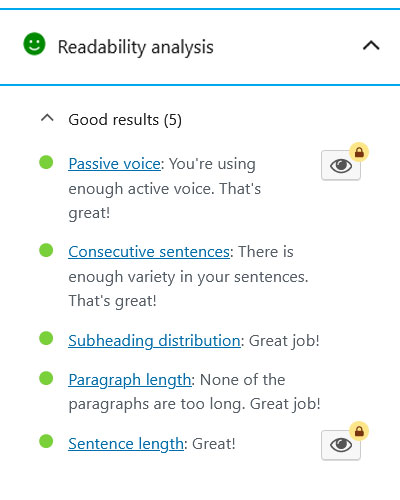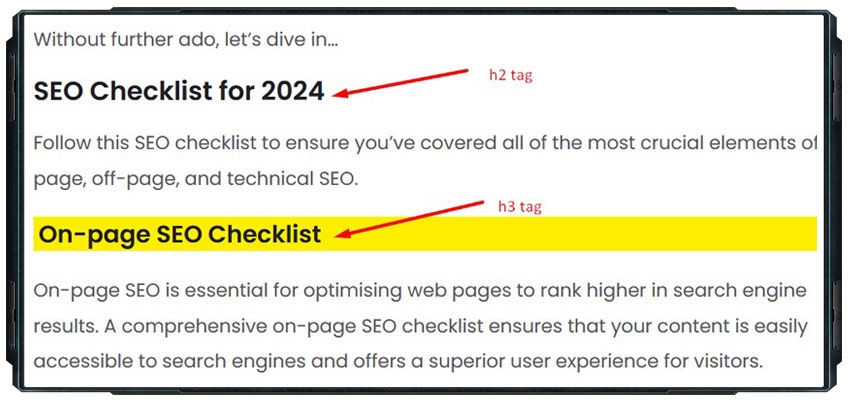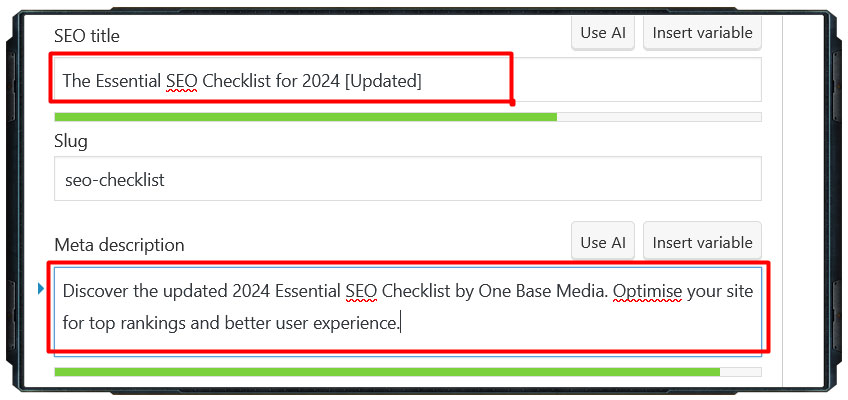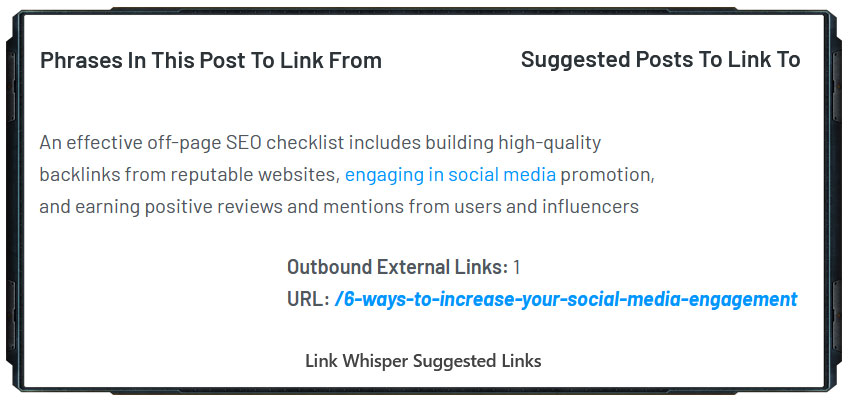
Even a seasoned marketing professional can’t always remember the components and principles that make up modern SEO. Especially when it comes time to audit your site and content, forgetting important elements of strong SEO can lower your rankings.
So whether you’re new to the game or just need another helpful marketing tool, we’ve put together an essential SEO checklist for 2024. Any time you’re auditing your website or want to improve your overall SEO, come back to this helpful checklist.
Without further ado, let’s dive in…
SEO Checklist for 2024
Follow this SEO checklist to ensure you’ve covered all of the most crucial elements of on-page, off-page, and technical SEO.
On-page SEO Checklist
On-page SEO is essential for optimising web pages to rank higher in search engine results. A comprehensive on-page SEO checklist ensures that your content is easily accessible to search engines and offers a superior user experience for visitors.
Key elements include optimising title tags, meta descriptions, and URL structures, as well as incorporating relevant keywords naturally into content. Benefits of a thorough on-page SEO strategy include increased organic traffic, improved site visibility, higher conversion rates, and enhanced user engagement. Overall, on-page SEO serves as a foundation for establishing a successful and sustainable online presence.
1. Produce high-quality content

Search engines only want to promote content that best serves user intent. For this reason, producing high-quality content is the first step in creating powerful and effective SEO. Don’t worry; a masterpiece isn’t needed here — content that easily meets user expectations is just right. Before publishing, it’s essential to run your content through a reliable plagiarism checker to ensure originality, as duplicate content can negatively impact your SEO rankings.
2. Keywords, keywords, keywords…

A driving force of your on-page SEO has to be keywords. Research valuable target keywords and try to mention them at least once every 200 words. Ensure they sound natural and unforced, as keyword stuffing is a confirmed way to lose brownie points with Google.
3. Audit titles and headers

Ordered header structure is so important for on-page SEO — both readers and web crawlers appreciate:
- Logical article structure (H1 > H2 > H3, etc.);
- Target keywords and phrases;
- Informational but catchy text.
4. Update meta descriptions and title tags

Meta descriptions and title tags explain to search engines and readers what your web page is all about. Don’t forget to add these to every page on your site. Fill them with your target keywords and engaging click-worthy text.
5. Add internal links

Just like how you included those keywords earlier, now add some internal links to other pages on your site. Find natural ways to link to other pages with their target keywords. Add as many as 5-6 for long-form content and at least two for shorter blog articles.
Off-page SEO Checklist
Off-page SEO focuses on activities outside your website that influence your search engine rankings. An effective off-page SEO checklist includes building high-quality backlinks from reputable websites, engaging in social media promotion, and earning positive reviews and mentions from users and influencers.
Guest blogging, social bookmarking, and participating in online forums and communities are also important off-page SEO strategies. The benefits of a strong off-page SEO approach include increased domain authority, improved search engine rankings, enhanced online reputation, and expanded reach to a wider audience.
Together with on-page SEO, off-page SEO contributes to a holistic and successful digital marketing strategy.
1. Examine backlinks
The internal link’s big brother is the backlink, which are links to your website from other, hopefully reputable, sites. Backlinks from websites with higher rankings earn a stronger link. Backlink audits also help to see who’s mentioning your site and to disavow any links from unreputable, “toxic domains”.
2. Produce guest posts, collaborations, etc.
A great way to garner some of these powerful backlinks is to reach out to other websites, brands, and influencers. You can often submit a guest post on a high-ranking blog with your backlink. Collaborations with other brands and influencers help to increase traffic to your site and possibly earn some valuable backlinks too.
3. Step up your social media game
If you want strong SEO and brand visibility, social media marketing is a no-brainer. Social media can power your SEO through various ways:
- Consistent, engaging posts with backlinks;
- Building followers and site visitors;
- Collaboration with influencers;
- Increase your business’s authority and reach.
Technical SEO Checklist
Technical SEO mostly focuses on the backend elements of your website that affect search engine rankings and user experience. A comprehensive technical SEO checklist includes optimising website speed by reducing loading times, ensuring mobile-friendliness and responsive design, implementing XML sitemaps and robot.txt files, and fixing crawl errors and broken links.
Additionally, enhancing website security with HTTPS encryption, using structured data markup for better SERP visibility, and improving site architecture for easier navigation are essential technical SEO practices.
Benefits of addressing technical SEO issues include improved site performance, better crawlability and indexing, higher rankings, and enhanced user satisfaction. Proper technical SEO lays a solid foundation for your website’s overall SEO strategy.
1. Pick a secure site structure
Are you still building your site on an HTTP domain? It’s time to switch to the preferable HTTPS (“S” for “secure”) because without it, you might not even get ranked. They are essentially the same, but HTTPS ensures a higher standard of data encryption, leading to higher rankings and a safer customer experience.
2. Build mobile-first
Mobile web traffic has represented over half of all online traffic for years. So, if your website isn’t mobile-friendly, you’re cutting out a huge chunk of possible sales. You can capitalise on this trend by building “mobile-first.”
3. Secure your work environment
There’s a simple fact — if your website becomes unsafe, your SEO is doomed. Malware can plant itself on your site in its early stages. Run antivirus for constant surveillance and ensure you encrypt all of your web traffic with a VPN (learn more about VPNs). Cyberthreats come in all shapes and sizes, so encompassing cybersecurity is key.
4. Boost your website speed
Just ask yourself, how long do you wait to load pages? Probably not very long — well, no one else does either. Compress your images, enable lazy loading, and minify your CSS and Javascript files. To boost mobile page speeds, try implementing AMP (an open-source HTML framework).
5. Submit XML sitemaps
Finally, you’re not going anywhere near the top result on Google until your site has been indexed. Generate XML sitemaps and make sure to submit them regularly to your target search engines.
Conclusion
If you’ve reached this point, your website’s SEO should be optimised to a high standard. Maintain consistency by posting top-notch content and adhering to this SEO checklist. With One Base Media, your trusted SEO marketing expert, you’re on track to get your site ranking on Google in no time.

Speak with our Google Ads Expert
Got a quick question about marketing your local business
with Google Ads? We can help.
Speak to one of our experts today on 01702 668207 or send us a message.
